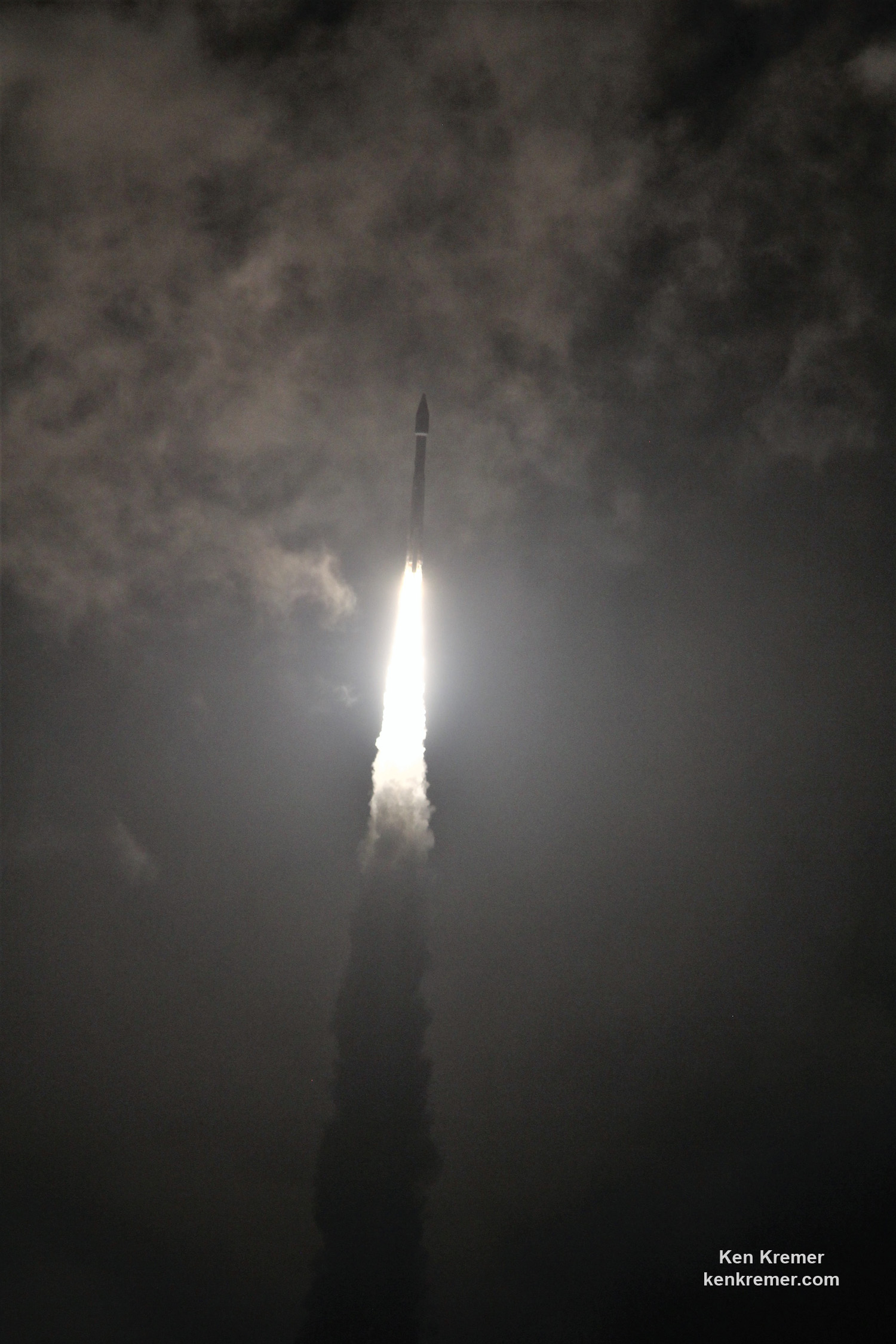
Covert NRO Satellite Fades into Capes Cloudy Night Skies Shrouded in Liftoff Secrecy: Gallery – As ULA Atlas Wins Landsat Launch


Covert NROL-52 spy satellite for the National Reconnaissance Office fades into cloudy nighttime skies shrouded in secrecy after liftoff on a United Launch Alliance (ULA) Atlas V rocket at 3:28 a.m. EDT on Oct. 15, 2017 from Space Launch Complex-41 at Cape Canaveral Air Force Station in Florida. Credit: Ken Kremer/kenkremer.com
CAPE CANAVERAL AIR FORCE STATION, FL — As one Atlas rocket carrying a covert spy satellite for the National Reconnaissance Office (NRO) to monitor Earth for national security purposes faded into cloudy nighttime skies over the Cape in the dead of night shrouded in liftoff secrecy, rocket builder United Launch Alliance (ULA) won another significant Atlas launch contract for NASA’s Landsat 9 satellite to monitor the health of Earth’s environment.
Capping two launches from two different rocket companies in four days by ULA and SpaceX followed by the arrival back in port of SpaceX’s ocean landed recovered booster, last week provided all the proof that’s needed to demonstrate that the revitalization of Florida’s Spaceport is well underway and America’s rocket makers are capturing lucrative launch contracts ensuring an upswing nationwide in rocket and spacecraft manufacturing – for military surveillance, government, civilian and science needs.
Check out the exciting gallery of Atlas launch imagery and videos including the thrilling droneship return of SpaceX’s 156 foot tall first stage booster back into Port Canaveral less than 4 hours after ULA delivered the classified NROL-52 surveillance satellite to a secret orbit – from this author and several space media colleagues.
A ULA Atlas V launch carrying the covert NROL-52 mission in support of U.S. national security blasted off overnight Sunday, Oct. 15 at 3:28 a.m. EDT (0728 GMT) from seaside Space Launch Complex-41 at Cape Canaveral Air Force Station in Florida.
“Congratulations to the team who helped make #NROL52 a success! United Launch Alliance, 45th Space Wing at Patrick Air Force Base, Fla., Air Force Space Command, and the Space and Missile Systems Center,” the NRO announced post launch on social media.
It was a case of ‘Going, Going, Gone’ as continuing storm weather plaqued the space and the Atlas soon disappeared behind clouds from many but not all vantage points, as the two stage rocket was finally cleared to launch on its fifth try. Postponed three times by poor weather and once due to a technical glitch to fix a faulty second stage transmitter.
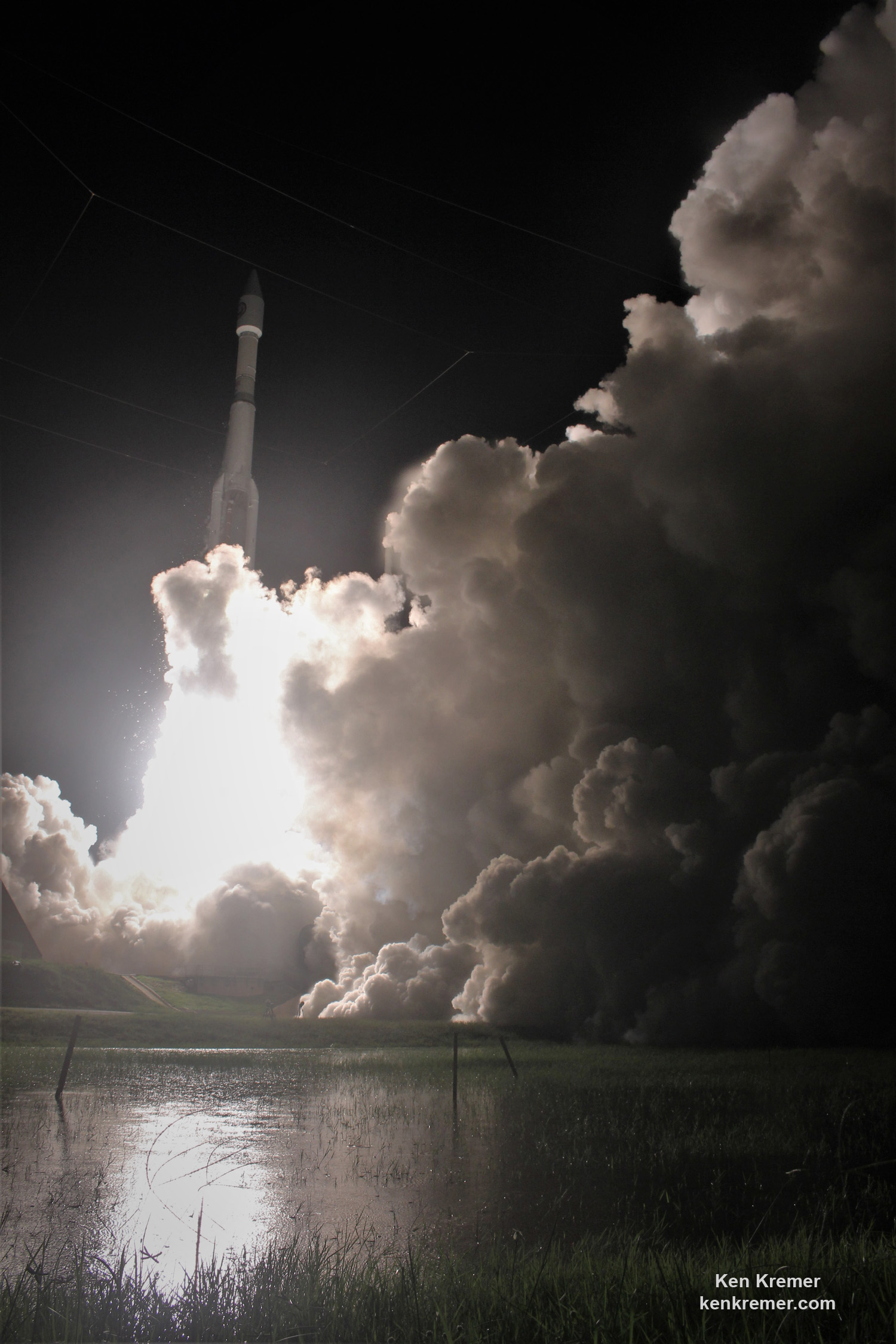
Reflecting in a pond a United Launch Alliance (ULA) Atlas V rocket blasts off with the covert NROL-52 spy satellite for the National Reconnaissance Office at 3:28 a.m. EDT on Oct. 15, 2017 from Space Launch Complex-41 at Cape Canaveral Air Force Station in Florida. Credit: Ken Kremer/kenkremer.com
The launches were postponed by the downstream impact of Hurricane Irma which forced the base closings of the Kennedy Space Center and Cape Canaveral Air Force Station and significantly impacted the Florida Space Coast region by causing over $100 million in damage to buildings, homes, business, hotels, restaurants, infrastructure and more due to flooding and high winds.
“We’ve had an incredible month,” said Brig. Gen. Wayne R. Monteith, Commander, 45th Space Wing. “Not only did we restore our base to full mission capable status just a few hours after Hurricane Irma impacted our coast, but we’ve successfully launched two rockets in less than four days just weeks later.”
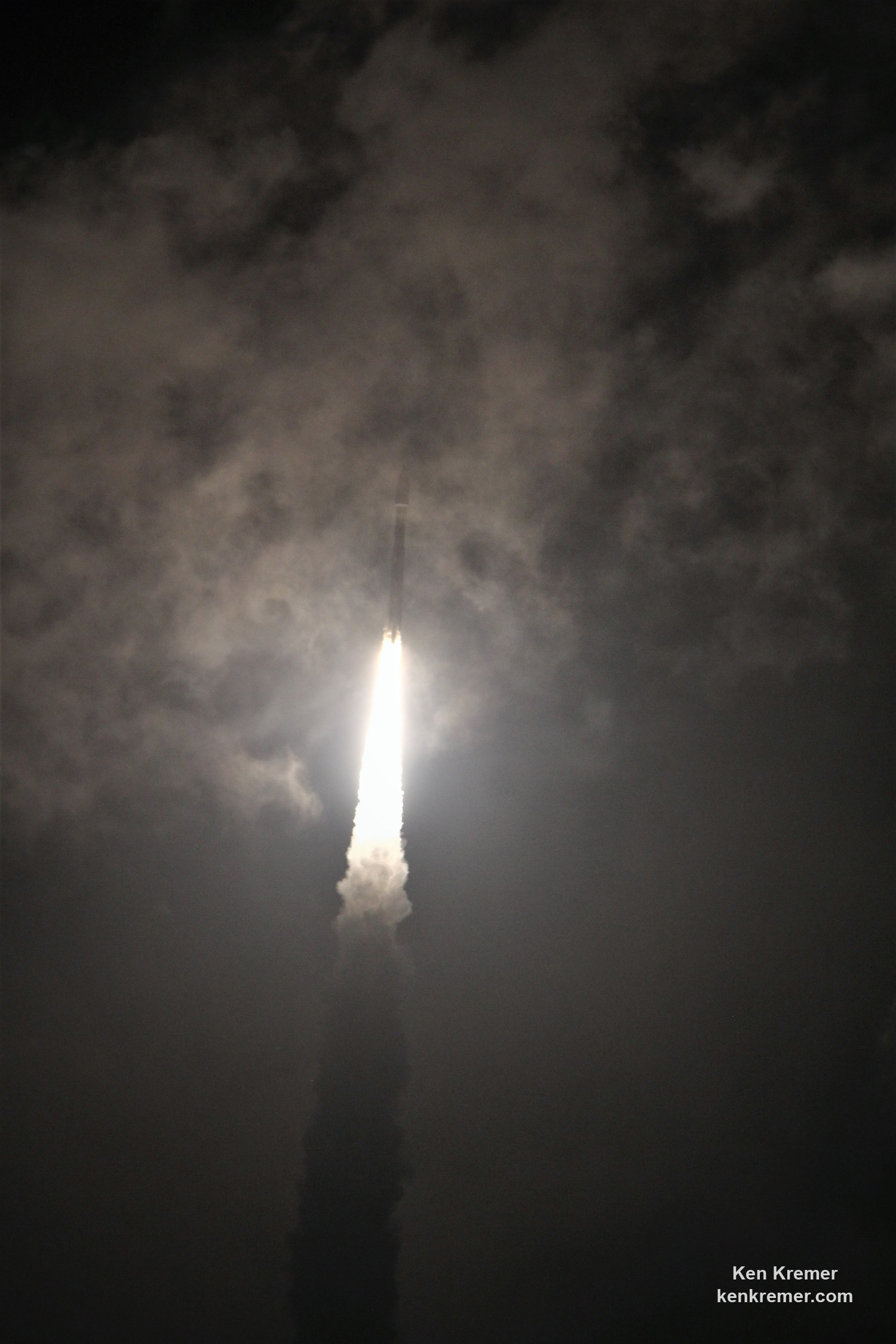
Covert NROL-52 spy satellite for the National Reconnaissance Office fades into cloudy nighttime skies shrouded in secrecy after liftoff on a United Launch Alliance (ULA) Atlas V rocket at 3:28 a.m. EDT on Oct. 15, 2017 from Space Launch Complex-41 at Cape Canaveral Air Force Station in Florida. Credit: Ken Kremer/kenkremer.com
“The 45th Space Wing supported ULA’s AtlasV launch of the NROL-52 mission for the National Reconnaissance Office early morning on Oct. 15!”
“The men and women of the 45th Space Wing continue to make the impossible possible.”
More than a quarter of all the world’s launch take place from Florida’s burgeoning spaceports.
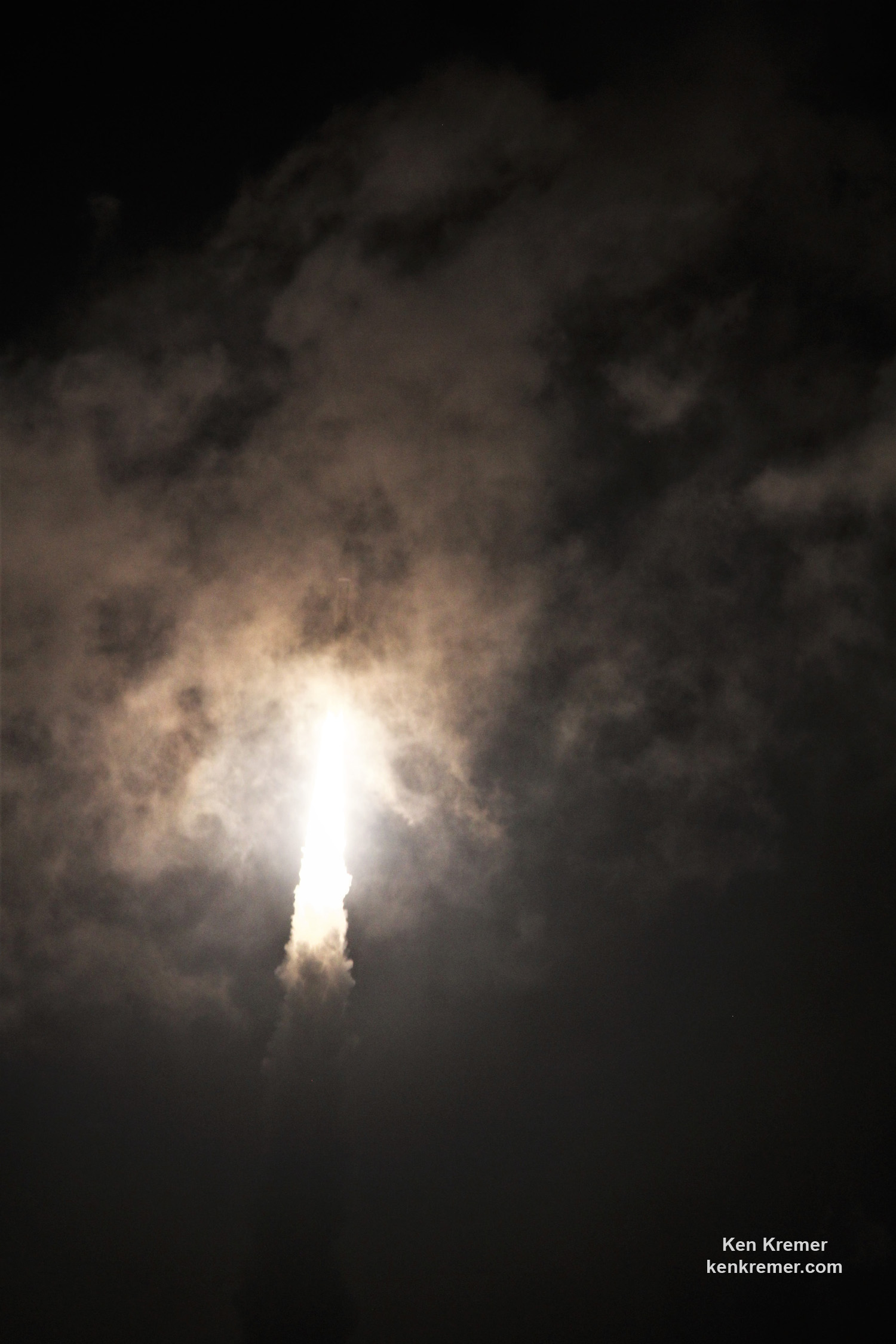
Covert NROL-52 spy satellite for the National Reconnaissance Office fades into cloudy nighttime skies shrouded in secrecy after liftoff on a United Launch Alliance (ULA) Atlas V rocket at 3:28 a.m. EDT on Oct. 15, 2017 from Space Launch Complex-41 at Cape Canaveral Air Force Station in Florida. Credit: Ken Kremer/kenkremer.com
“Our team’s resiliency and tireless efforts in launching over 25% of all world-wide launches this year proves why we are the ‘World’s Premier Gateway to Space,’” Montieth gushed in pride.
Meanwhile, NASA selected ULA provide launch services for the Landsat 9 mission.
“The mission is currently targeted for a contract launch date of June 2021, while protecting for the ability to launch as early as December 2020, on an Atlas V 401 rocket from Space Launch Complex 3E at Vandenberg Air Force Base in California,” said NASA.
The Landsat 9 launch contract and other mission-related costs is worth $153.8 million, which includes the launch service and Landsat 9 is a joint mission between NASA and the U.S. Geological Survey (USGS).
“Landsat 9 will continue the Landsat program’s critical role in monitoring, understanding, and managing the land resources needed to sustain human life.”
“We are honored that NASA has entrusted ULA with launching this critical land imaging satellite,” said Tory Bruno, ULA’s president and chief executive, in a statement.
“ULA’s world-leading performance and reliability, paired with the tremendous heritage of 74 consecutive successful Atlas V launches, provides the optimal value for our customer. We look forward to working together again with our mission partners at NASA’s Launch Services Program, Goddard Space Flight Center and the U.S. Geological Survey in the integration and launch of this significant mission, contributing to the international strategy for examining the health and state of the Earth.”
NROL-52 is the fourth of five launches slated for the NRO in 2017 by both ULA and SpaceX.
“Never before has innovation been more important for keeping us ahead of the game. As the eagle soars, so will the advanced capabilities this payload provides to our national security,” said Colonel Matthew Skeen, USAF, Director, NRO Office of Space Launch, in a statement. “Kudos to the entire team for a job well done.”
Check out this exciting video compilation from remote cameras circling the Atlas pad 41.
Video Caption: Launch of the NROL-52 satellite on an Atlas 5 booster from Pad 41. A United Launch Alliance Atlas 5 421 rocket launches the NROL-52 payload on Oct. 15, 2017 at 328 a.m. EDT on the 5th launch attempt. Previous launch attempts were halted by weather issues 3 times, and a faulty telemetry radio that needed to be replaced after the rocket was rolled back to the Pad 41 Vertical Integration Facility. Credit Jeff Seibert
The next NRO launch is scheduled on a ULA Delta IV in December from Vandenberg Air Force Base, California.
Watch for Ken’s continuing onsite NROL-52, SpaceX SES-11 and NASA and space mission reports direct from the Kennedy Space Center and Cape Canaveral Air Force Station, Florida.
Stay tuned here for Ken’s continuing Earth and Planetary science and human spaceflight news.
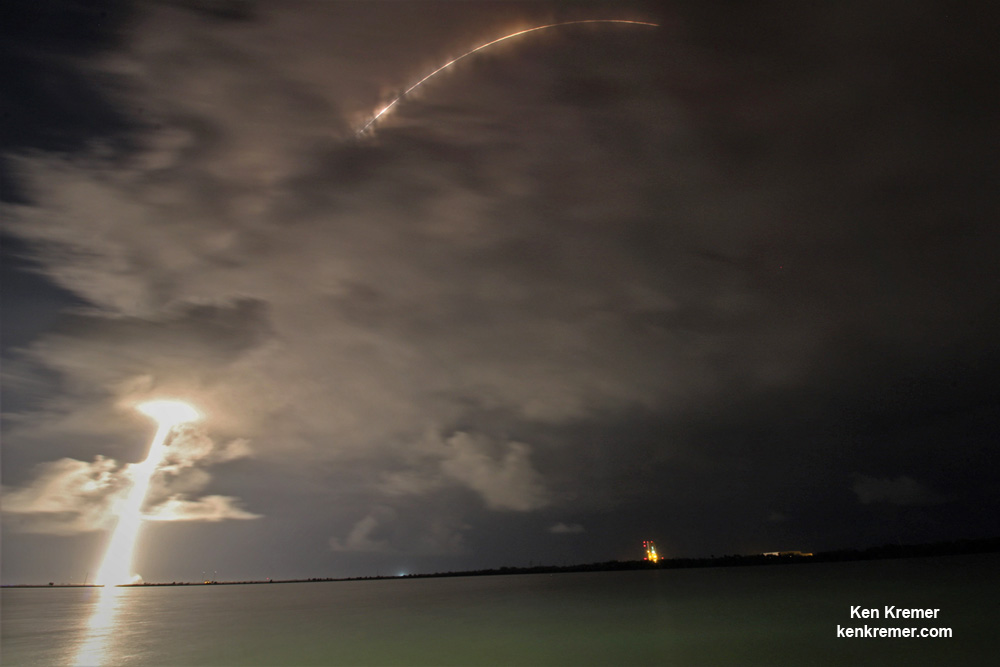
United Launch Alliance (ULA) Atlas V rocket streaks to orbit in this long duration exposure carrying covert NROL-52 payload for the National Reconnaissance Office after lift off from Space Launch Complex-41 on Oct. 15, 2017 at 3:28 a.m. EDT at Cape Canaveral Air Force Station in Florida. Credit: Ken Kremer/kenkremer.com
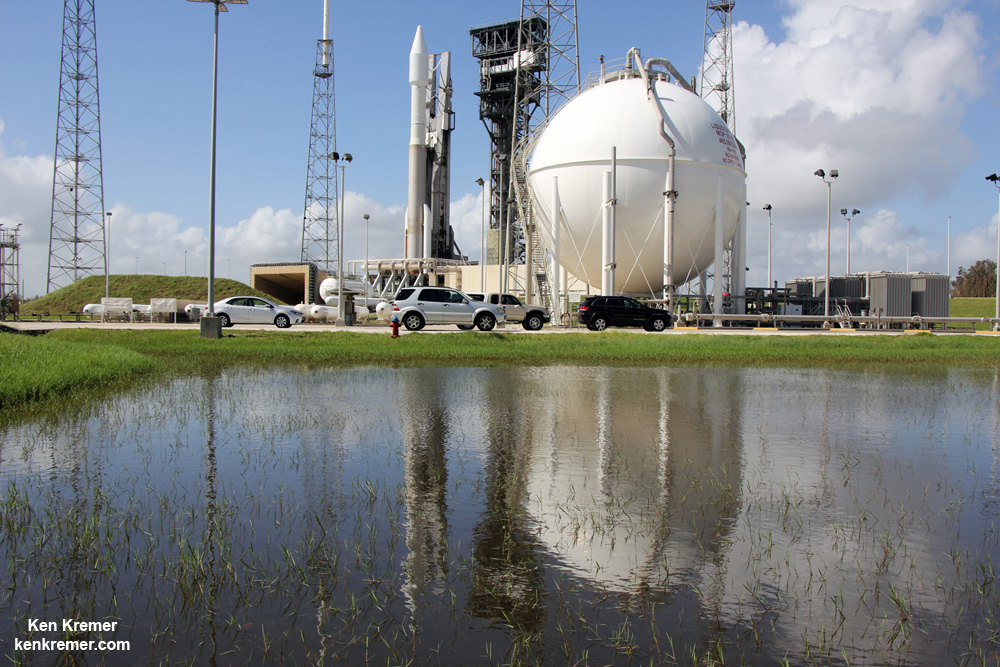
Reflecting in a pond a ULA Atlas V rocket stands poised for launch with the NROL-52 surveillance satellite for the National Reconnaissance Office prior to blastoff on Oct. 15, 2017 from Space Launch Complex-41 at Cape Canaveral Air Force Station in Florida. Credit: Ken Kremer/kenkremer.com
The post Covert NRO Satellite Fades into Capes Cloudy Night Skies Shrouded in Liftoff Secrecy: Gallery – As ULA Atlas Wins Landsat Launch appeared first on Universe Today.
Universe Today
Go to Source
Powered by WPeMatico